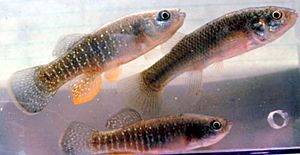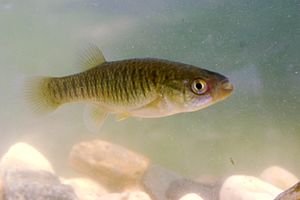Mummichog facts for kids
Quick facts for kids Mummichog |
|
|---|---|
 |
|
| Conservation status | |
| Scientific classification |
The mummichog (Fundulus heteroclitus) is a small fish that lives along the Atlantic coast of the United States and Canada. People also call them Atlantic killifish, mummies, gudgeons, or mud minnows. These fish live in brackish (slightly salty) and coastal waters. This includes places like estuaries (where rivers meet the sea) and salt marshes.
Mummichogs are known for being very tough. They can handle big changes in how salty the water is. They can also survive in very hot or cold water, from 6 to 35 degrees Celsius (43 to 95 degrees Fahrenheit). They can even live with very little oxygen in the water. Because they are so tough, scientists often study mummichogs. They learn about how fish grow, how their bodies work, and how they react to pollution. In 1973, a mummichog was the first fish ever sent into space aboard Skylab!
Contents
About the Mummichog's Name
The scientific name for the mummichog is Fundulus heteroclitus. The first part, Fundulus, comes from a Latin word meaning "bottom". This is because these fish often swim near muddy bottoms. The second part, heteroclitus, means "unusual" or "irregular".
A famous scientist named Carl Linnaeus first described this fish in 1766. He found it near Charleston, South Carolina. The name "mummichog" comes from a word used by the Narragansett people. It means "going in crowds," which is perfect because mummichogs often swim in large groups.
People have many other names for this fish, like mummy, killie, or mud dabbler. Sometimes these names can be confusing. For example, "minnow" usually refers to a different type of fish.
What Mummichogs Look Like
Mummichogs have a long, thick body. Their tail area is quite deep. They usually grow to be about 7.5 to 9 centimeters (3 to 3.5 inches) long. But some can grow up to 15 centimeters (6 inches)! Their mouth points upwards, and their lower jaw sticks out a bit when their mouth is closed. Both their pectoral (side) fins and tail fins are round.
Mummichogs have different numbers of rays (like spokes) in their fins. Males have larger dorsal (top) and anal (bottom) fins than females. They don't have a visible lateral line along their body, but they do have special pores on their head.
Their color can change, but they are usually olive-brown or olive-green. They might have thin, wavy, silvery bars on their sides. During the breeding season, males become much brighter. Their backs turn dark olive-green, their sides become steel-blue with about 15 silvery bars, and their bellies turn yellow or orange. Their dorsal fin might have a spotted pattern, and a small eyespot might appear near the back edge. Females are usually paler and don't have the bright colors or bars.
There are two types of mummichogs, a northern type and a southern type. They look a little different. Also, the northern type lays eggs with sticky threads, while the southern type lays eggs without them. The southern type often lays eggs inside empty mussel shells.
Mummichogs look a lot like the banded killifish. However, banded killifish usually live in freshwater, while mummichogs prefer salty or brackish water. Also, banded killifish have dark bars on a light body, while mummichogs have light bars on a darker body.
Where Mummichogs Live and Their Habitat
Mummichogs live along the Atlantic coast of North America. You can find them from the Gaspé Peninsula in Canada all the way down to northeastern Florida. They have also been introduced to other places. For example, they now live on the Atlantic coast of Portugal and Spain. Sometimes, they are released into freshwater habitats as bait fish and can survive there.
These fish are very common in coastal areas. They like places like salt marshes, muddy creeks, and tidal channels. They can also be found in coastal rivers, but usually not too far upstream.
What Mummichogs Eat
Mummichogs are omnivores, which means they eat both plants and animals. Scientists have looked inside their stomachs to see what they eat. They found tiny plants called diatoms, small crustaceans (like shrimp), mollusks (like snails), fish eggs (even their own!), very small fish, insect larvae, and bits of eelgrass.
How Mummichogs Survive Tough Conditions
This fish is famous for being able to live in many different kinds of environments. They can handle temperatures from 6 to 35 degrees Celsius (43 to 95 degrees Fahrenheit). They can even survive quick temperature changes. They are also very good at handling different salt levels in the water. Young mummichogs can grow in water that is almost fresh or water that is three times saltier than normal ocean water!
Adult mummichogs can survive when there's very little oxygen in the water. If oxygen levels get too low, they will swim to the surface and breathe the thin layer of water that touches the air, which has more oxygen. They can even survive for a few hours out of water if it's moist, by breathing air directly!
Some groups of mummichogs have even developed ways to resist pollution. They can live in places with high levels of harmful chemicals like mercury and dioxins. Scientists have found that about 20% of their genes have changed in these polluted areas compared to fish living in clean places.
Mummichog Behavior
Mummichogs usually live in large groups called shoals. These groups can have hundreds of fish.
During cold winters in northern areas, mummichogs move to deeper tidal pools. They can burrow into the mud up to 20 centimeters (8 inches) deep to stay warm. They can also bury themselves in the mud if a tidal pool starts to dry out. Sometimes, they can even wiggle short distances on land to get back to the water.
Scientists have studied mummichogs in the lab and found that they have clear daily rhythms, like our own circadian rhythms (sleep-wake cycles). Their body color and swimming activity follow these rhythms. They also have rhythms linked to the moon, with egg production peaking every 14.8 days for several months.
Reproduction
Mummichogs lay eggs from spring through fall. In warmer areas, they can lay eggs up to eight times in one season. They usually lay eggs at high tide, especially when the moon is new or full. The best time for them to lay eggs is when high tides happen at night.
During courtship, male mummichogs might chase females. Females might attract males by turning on their sides near the bottom and flicking their tails. A male and female might swim together. Then, the male will push the female against a rock or plant and wrap his larger fins around her body. Small bumps on the male's scales help him hold onto the female. The pair will then shake quickly, releasing eggs and sperm.
The eggs are pale yellow and about 2 millimeters (0.08 inches) wide. They are very sticky. A female can lay up to 740 eggs in one event, in smaller groups of 10 to 300 eggs at a time. The eggs stick to plants, algae, empty mussel shells, sand, or mud. They are laid in spots that only get covered by water during the highest tides. This means the eggs develop while exposed to moist air. They hatch when the next high tide reaches them. The eggs need still water with low oxygen to hatch, which happens when they are covered by water at high tide.
Most mummichogs are ready to reproduce when they are two years old and about 3.8 centimeters (1.5 inches) long. They usually live for about four years.
Mummichogs and Humans
Mummichogs are helpful because they eat mosquito larvae. People have tried to use them as a natural way to control mosquito populations.
Fishing
Mummichogs are often sold as bait for sport fishing. People use them to catch fish like summer flounder and bluefish. They are very popular bait fish in the Northeast of America.
Scientific Utility
Mummichogs are very important for science. They are considered a "model organism" because they can handle so many different extreme conditions. This includes chemical pollution, as well as changes in temperature, saltiness, and oxygen levels. They are easy to find, catch, and keep in labs.
Scientists use mummichogs to study how living things deal with stress, how their bodies work in different temperatures, and how they react to poisons. They also study them to learn about evolution, how animals develop, hormones, cancer, and daily rhythms. Now that scientists have mapped the mummichog's entire genetic code, they are even better for studying how living things respond to their environment.
Their amazing ability to handle extreme conditions has made them popular for studies on pollution. For many years, they have been used to study how single chemicals, mixtures of chemicals, and polluted areas affect living things. Sometimes, they are the only fish species found in very polluted waterways. For example, a report in 2008 found that many mummichogs from the Elizabeth River in Virginia had cancerous growths because of high levels of certain chemicals.
Mummichog eggs are also used in studies about how animals develop. They are great for teaching about embryology because you can easily see their eyes, beating heart, and different stages of growth. The embryos are also very tough and easy to work with in the lab.
As mentioned, mummichogs were the first fish to go to space! In 1973, a few mummichogs were sent into space in a plastic bag aquarium aboard Skylab. At first, they swam in circles because there was no gravity. But after 22 days, they learned to swim normally. Fifty mummichog eggs also went to space, and 48 of them hatched during the flight. The baby fish swam normally too! More experiments with mummichogs in space happened later, including on the Apollo-Soyuz Test Project and the Bion 3 satellite.
See also
 In Spanish: Fundulus heteroclitus para niños
In Spanish: Fundulus heteroclitus para niños



